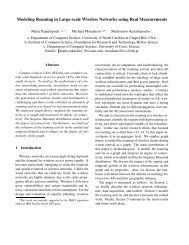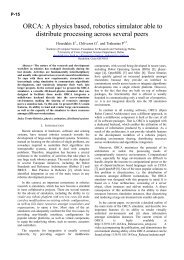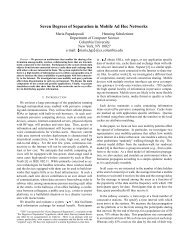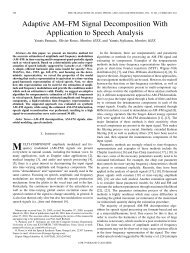Master Thesis - ICS
Master Thesis - ICS
Master Thesis - ICS
You also want an ePaper? Increase the reach of your titles
YUMPU automatically turns print PDFs into web optimized ePapers that Google loves.
Computer Science Department<br />
Antonis Misargopoulos<br />
Figure 4.2: Relation<br />
Q = R * S<br />
The natural join operation can be written as<br />
R ∗ S = π R >< ],<br />
( a b −s(<br />
a))<br />
[<br />
r(<br />
a)<br />
s(<br />
b)<br />
S<br />
i j<br />
=<br />
where a and b are the attributes in relations R and S, respectively. The result relation Q is<br />
given by<br />
Q = { t | t = ( rs − s(<br />
a))<br />
∧ r ∈ R ∧ s ∈ S ∧ r(<br />
a)<br />
= s(<br />
b)}<br />
.<br />
The result of<br />
R ∗ S on the payscale attribute is the relation Q in figure 4.2.<br />
• Semi-Join<br />
In the conventional execution of the join operation, the resulting relation has all the<br />
attributes of both input relations. Sometimes it is required that only the attributes of one<br />
of the relations be present in the output relation. The semi-join operation is designed to<br />
perform such a join [109]. It has also been defined as an operation that selects a set of<br />
tuples from one relation that relate to one or more tuples in another relation. The<br />
relationship is defined by the join condition. It is equivalent to the join of the two<br />
relations followed by a project operation that results in the attributes of the second<br />
relation being dropped from the output relation. The initial join itself may be performed<br />
by any of the join techniques. The semi-join operation is written as<br />
R >p<br />
r( a)<br />
ϑs(<br />
b)<br />
S = π<br />
a<br />
[ R ><<br />
r(<br />
a)<br />
s(<br />
b)<br />
S]<br />
i ϑ<br />
,<br />
and the result relation Q is given by<br />
38

















